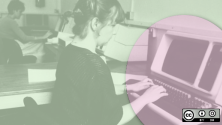The year was 1996. December 1996 to be more precise. I had just finished my first semester of college and was spending Christmas at my uncle's apartment in Port Jefferson, New York. My uncle was a PhD student studying computational geometry and eager to show me some of his work. He was especially interested in telling me about this free Unix-like operating system that came with a book he had bought.
In that system, he could connect to the University's remote shell services, write and compile C and C++ code without having to buy Borland or Microsoft's IDE/Compilers, surf the web, and send out emails. Free. You could install it, share it. There were no serial numbers. Nothing.
The book my uncle had bought was called Red Hat Unleashed from Sam's Publishing. It came with a CD on the back cover with Red Hat Linux 3.0.3 (Picasso). During the few days I stayed with my uncle, he showed me some of his work and also took me to Borders bookstore ('90s flashback!) and gave me my very own copy of that book.
The new year arrived, and with it a new semester of school. I decided I was going to install this Linux thing, and get permission from my advisor to hand in my programming assignments compiled with gcc instead of the proprietary alternatives we were using in class. I got the green light from my professor, and off I went.
The first time I tried installing Red Hat Linux on my Packard Bell 133 Mhz with a screaming 8MB of RAM, I was so lost I almost gave up on it. Back in those days, the installer (if you could call it that) didn't detect anything for you. You basically had to know off the top of your head things like: if your hard drive is installed on your primary or secondary, master or slave IDE, what type of video card chipset your computer is compatible with, types of modems, ethernet card (which I didn't have), and pointer device (i.e. mouse). I can recall actually having to open up my machine to look at the IDE cables to see what options I would have to choose during the installation.
I almost forgot to mention that there was no such a thing as a bootable CD. You had to create bootable floppy disks in Windows to boot the CD. It took me hours to get Picasso installed, and back then Red Hat was already known for being one of the easiest installations around.
Fast forward about a year to October 1997. I am now a sophomore working in the Windows-and-Mac-only computer lab. I decided to go to my boss and ask for permission to stand up a Linux server for computer science students to play with. My boss gave me a older, soon to be retired machine. I once again went to my professor and created him an account, and he started to throw in Linux based assignments in some of his courses. The CSAR server (which stood for Computer Science Academic Resource) was born, and it was the first Linux-based server at my university.
I remember one time trying to set up Samba on my workstation so I could share files with the lab computers, and accidentally making my workstation the domain controller for the entire lab and nobody could login. The network administrator at the time was so mad at me and told me something to the effect that if I didn't start reading documentation and being more careful that he was going to ban Linux from his network. I don't think RTFM existed back then, did it?
As time went on, I became more and more into Linux. I ran Linux on my personal computer, on my workstation at the lab, and throughout my college years. Like an old-time gospel evangelist, I preached to many about the benefits of open source over proprietary solutions.
From those days until today, I have never had a job that didn't give me the flexibility to run Linux as my operating system. I've been fortunate enough to have had managers who were more interested in me being efficient rather than compliant with the company's policy. Every single one of them when they saw me automating manual processes with Perl, awk, bash, sed, would without hesitation say: "Sure, use Linux! Tell me more about it while you are at it."
In 2007, everything came full circle when I started working for Red Hat, the company behind my very first Linux distribution. My Linux adventure started back in 1996, and throughout all these years, I have had the satisfaction of hearing back from former college friends who borrowed many copies of Red Hat Linux from me and today are in the technology field as successful solutions architects, developers and system administrators all because of the empowerment of open source.
And in case you are curious, my uncle who introduced me to Linux did end up getting his PhD, moving back to Brazil and is currently a Computer Science professor in one of the top universities there.
This article is dedicated to my uncle, Ricardo Farias, Associate Professor @ the Federal University of Rio de Janeiro
This article is part of a series called My Linux Story. To participate and share your Linux story, contact us at: open@opensource.com.







5 Comments